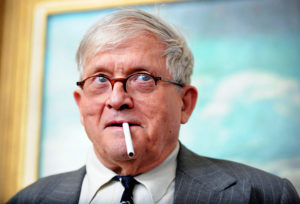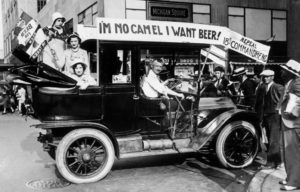When the Labour government of Tony Blair banned smoking in enclosed public spaces, it was completing an agenda that had been outlined 20 years earlier, in an episode of the sitcom Yes, Prime Minister: “A complete ban on all cigarette sponsorship and advertising, even at the point of sale. £50 million to be spent on anti-smoking publicity. Ban smoking in all public places. And progressive, deterrent tax rises over the next five years until a packet of 20 costs about the same as a bottle of whisky.” Back in 1986, the studio audience had laughed at such draconian proposals; now, in 2006, they were government policy.
And yet, the evil of cigarettes has not been fully extinguished. Which is why the Conservative government of Rishi Sunak is proposing that those in their late teens should become the last generation ever to smoke legally in this country. Policy to be announced this week in the King’s Speech will eradicate tobacco from our society as surely and comprehensively as cannabis and cocaine have been.
None of this is particularly new, of course. Official disapproval of smoking goes back as far as James I’s 1604 pamphlet A Counterblaste to Tobacco, though it took another three centuries for the government to get fully involved. The spur then was the outbreak of the Boer War in 1899, which saw a flood of recruits to the colours, young men who were employed as servants, shopworkers, clerks and labourers. But if working-class patriotism was in fine fettle, the same could not be said of working-class health. Around three in 10 who applied to join the ranks were rejected on medical grounds. This worrying state of affairs, said some, was down to the advent of the cheap cigarette.
“The chief cause of unfitness was proved to be smoking,” declared Percy Everett, a magazine editor who later co-wrote Scouting for Boys with Boer War hero Robert Baden-Powell. The habit was responsible for “upwards of 80 diseases, including blindness and cancers of the lower lip and tongue, and is credited with killing 20,000 each year”. In short, it was “an evil which is sapping our boyhood’s strength, and so undermining our national manhood”. Smoking, like masturbation, was linked to blindness and insanity.
In response to such concerns came the Children’s Act of 1908, passed by H. H. Asquith’s Liberal government, which introduced the first restrictions. It became illegal to sell tobacco products to anyone under the age of 16, and policemen and park keepers were authorised to confiscate tobacco, cigarettes and cigarette papers from underage smokers; they could also search boys for such items — though, for reasons of delicacy and decency, not girls.
Adults, however, continued to smoke freely for six decades, until the evidence of the harm it caused became too great to ignore. The medical profession demanded a government intervention and in 1965 — when 70% of men and 40% of women smoked — television adverts for cigarettes were banned. (Other tobacco products fared better: “Happiness is a cigar called Hamlet” ads were still being aired on TV into the Nineties.) The ensuing introduction, in 1971, of warnings on packets — “Smoking can damage your health” — wasn’t entirely successful. A 1975 poll showed that a third of smokers didn’t believe cigarettes could kill. The wording was accordingly ramped up, to include the word “seriously”.
There was also an effort to encourage switching to weaker cigarettes. A league table was published, showing the potency of the various brands. The implication was that if you were on Capstan Full Strength — which offered 38mg of tar per cigarette — you might be better off if you traded down. The Embassy Ultra Mild had just a tenth of those levels.
Advertising restrictions didn’t apply to sponsorship, though. Sport was a particularly attractive partner, since it enabled the brand-names and logos to be displayed on television. Snooker even offered the opportunity to see sportsmen light up while competing. There was also footballer John “Bionic” Osborne, a goalie for West Bromwich Albion, who was famously photographed having a quick smoke during a match in 1972, while the ball was down the other end.
Some, feeling that government action was painfully slow, took matters into their own hands. In 1971, the New Inn in Appletreewick, West Yorkshire declared itself Britain’s first no-smoking pub. It was reported that takings slumped. Later that year, a GP made the news when he refused to accept as patients a 45-year-old woman or her eight children because she had chronic bronchitis and wouldn’t give up smoking. She’d had a 15-a-day habit before the rejection; after, she claimed: “I have become so distraught that I now find I am getting through 30 cigarettes a day.”
Between government initiative and peer pressure, the number of smokers steadily fell, as did the number of places where one could indulge. The restrictions were not always popular, however. In 1982, British Rail banned smoking in the buffet cars of its Southern Region trains, but found itself overwhelmed by complaints and forced to back down. Two years later, smoking was prohibited on Tube trains in London, despite a survey showing only 18% of passengers in favour of a ban and 54% against. By then, only around a third of adults smoked.
It was around this time, though, that public attitudes really changed. Evidence for the negative effects of passive smoking began to accumulate, and there was no coming back from that. In the Nineties, diktats were issued from Brussels that radically reduced the maximum tar yield per cigarette — even as the Common Agricultural Policy was pumping millions into subsidising tobacco production. (An exception was made for Greece, which really liked a strong smoke, and negotiated an opt-out until 2006).
In response to this directive, the other John Osborne — the playwright, not the footballer — wrote a splendidly vitriolic letter to The Times, railing against those who had deprived him of his favourite Turkish cigarettes; “untipped, robust and fragrant”, they were “one of life’s few and reliable pleasures”. The restriction was “craven abasement” to “puny tyrannies”, to countries that had so recently been dictatorships. “As a schoolboy, I narrowly escaped from ‘European’ bombs on my doorstep,” wrote Osborne. “I can forgive this eagerness, but not the compounding of the insult by dashing the tobacco from my lips 40 years on.”
Those who objected to government action on smoking — and they tended, like Osborne, to be awkward individualists — insisted that this was a question of the liberty of the individual. The war against smoking was a “new Puritanism”, said Nicholas Ridley, Margaret Thatcher’s environment secretary: “A crusade to stop others doing what they want or taking risks with their own lives.” (Ridley refused to give up smoking even when diagnosed with lung cancer.) And when David Simpson, formerly of Amnesty International, took over the anti-tobacco lobby group Action on Smoking and Health in 1979, journalist Bernard Levin spotted an irony: “Have all those years of admirable work on behalf of the oppressed and persecuted taught him nothing about the indivisibility of freedom?”
Like our modern culture wars, the division has not been between Left and Right: over the years, Conservative, Labour and Liberal governments have all been on the same page about tobacco. Rather, it’s been between polite society — those who know they know better — and those who need to be protected from themselves. John Reid, health secretary in Tony Blair’s government, described the war against tobacco as “an obsession of the learned middle class”, and Diane Abbott saw it in similar terms in 2006: “Under New Labour, the party has gone from speaking for the white working class to speaking at them — whether about junk food or the smoking ban.”
There was some truth in this. The four-decade-long campaign had successfully reduced the number of smokers, but its impact was shaped by income and social class. Cigarettes had become unfashionable among the middle classes, but 42% of unskilled workers still smoked, as did 55% of single mothers. According to the Office for National Statistics, the imbalance remains: those with no educational qualifications are four times more likely to smoke than those with a degree.
Education, taxation and location having not been enough, there now comes a new policy to stub out smoking altogether. Sunak’s proposal is to raise the age at which one can purchase tobacco products by a year, every year, so that those now too young to smoke will forever be too young. It’s based on a similar law passed in New Zealand last year, and it will presumably pass through Parliament without much of a hitch — because in government, and in public opinion, the war has been comprehensively won. A taste for tobacco has become the love that dare not speak its name. Smokers are down to fewer than one in eight of the adult population. A YouGov poll last month showed a third of people supporting the proposed age-restriction; when you added in the 29% who wanted a complete ban immediately, it’s clear that Sunak has the public onside.
Those who fear similar net-zero campaigns elsewhere — against alcohol, the wrong foodstuffs, cars, fireworks, whatever — might note with concern the pattern of public response to every step of the anti-smoking pathway. First, complaints, then ridicule, swiftly followed by compliance and acceptance. It took a while, but there was no rebellion. That studio laughter on Yes, Prime Minister is the sound of a different world.
Admittedly, the suppression of tobacco was greatly aided by an increased understanding of secondary smoking, but once the principle of prohibition is established, it becomes easier to administer. There’s no known secondary harm from vaping, for example, but restrictions have still been imposed by the Conservative government, and there will be more to come. In particular, there are objections to flavoured vapes, since these are assumed to be more attractive to children.
That’s not new, either. The same thinking was seen in the European directive that banned menthol-flavoured cigarettes — though its most notable objector was not a child, but Helmut Schmidt, the venerable ex-chancellor of West Germany. As well as being possibly the last major European statesman to carry a snuff-box, Schmidt was a chain-smoker, and it was reported that he bought up a stash of 38,000 mint-flavoured fags, which proved sufficient to see him through to his last puff. It’s not clear whether he bought enough. He died just shy of his 98th birthday.
Disclaimer
Some of the posts we share are controversial and we do not necessarily agree with them in the whole extend. Sometimes we agree with the content or part of it but we do not agree with the narration or language. Nevertheless we find them somehow interesting, valuable and/or informative or we share them, because we strongly believe in freedom of speech, free press and journalism. We strongly encourage you to have a critical approach to all the content, do your own research and analysis to build your own opinion.
We would be glad to have your feedback.
Source: UnHerd Read the original article here: https://unherd.com/





